Exploring Digital Games with Teacher Voice Leaders
One of the most exciting things about receiving a grant from the Bill and Melinda Gates Foundation is the opportunites the foundation provides to connect and collaborate with other organizations. Last week, Michael Levine and I had the chance to attend the Gates Foundation’s annual convening of organizations working on Teacher Effectiveness. The groups who attended and presented at this meeting, including The Center for Teaching Quality, VIVA Teachers, Educators 4 Excellence, Purpose, Student Achievement Partners, The Hope Street Group (and many more), are expanding the idea of “Teacher Voice” by supporting teachers in their efforts to innovate the profession and play a larger role in shaping education reform across the country. Along with the leadership of each organization, a number of classroom teachers affiliated with each group attended the convening to participate in the workshops and meet other leaders within the teaching profession.
The Cooney Center was invited to lead a hands-on workshop for these classroom teachers that explored some of our recent research around games and learning. We also introduced the next phase of our research on teacher/parent experiences using digital games with children at home and at school. After playing some online games and watching our video case studies, we had a lively and informative discussion about what works (and what doesn’t!) around using digital games in the classroom. As always, a great deal of attention was paid to assessment, and how games can play a role in reaching all the learners in our classrooms.
We took this opportunity to meet and engage with this highly motivated group of teachers very seriously—we want to learn from their experience and use this knowledge to help shape our upcoming Games and Learning initiatives. At the end of our workshop, we solicited ideas for new topics and questions to field in the next phase of our National Teacher Survey, and we hope to hear from many more teachers over the next few weeks. If you are classroom teacher interested in learning what other teachers think about games and learning, please contribute your own topic ideas via this online form!
Toontastic Jr. and the Brave New World of Online Creative Co-Play
Avast! Today marks an exciting day for our hornswoggling crew here at Launchpad Toys: Toontastic Jr. Pirates is LIVE in the App Store for iPhone and iPad! With 3 million cartoons created in over 150 countries, our first app – Toontastic – has been a great success for kids ages 6-12. Now, with the launch of Toontastic Jr. and our new StoryShare platform for online, creative Co-Play, little brothers and sisters as young as 3 years old can create their own cartoons collaboratively in real-time with friends and family anywhere in the world.
Designing for Co-Play
As most parents can attest, getting a young child to talk on the telephone or Skype can be quite an endeavor — abstraction and lack of context makes it challenging to hold kids’ attention. Yet, sit that child down with a toy box of dolls or action figures and you’ll find yourself awash in a sea of chatter. Kids communicate naturally through imaginative play, learning about the world around them through creative collaboration with peers and family, using toys as contextual catalysts for conversation.
In designing for Co-Play, our challenge is conceptually simple, but technically complex: empower kids and their families to create and communicate as naturally and fluidly as they would playing with a box of LEGOs. The Cooney Center’s recent report on Co-Viewing outlined some great tips for this, three of which we found particularly inspiring in creating Toontastic Jr.’s StoryShare feature — we hope they serve you well too!
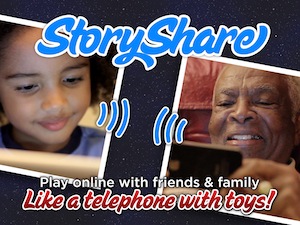 Build Synchronous, Shared Workspaces
Build Synchronous, Shared Workspaces
With sites like Facebook and YouTube, “sharing” has become synonymous with posting and uploading. Yet as our 3-year-old play-testers reminded us, we’d forgotten about the original form of sharing — not just sharing what you create, but sharing in the creation process itself. Co-Play, our first foray into “social” media as kids, requires real-time collaboration, open chat, and shared workspacesthrough which kids can communicate, imagine, and create freely. With Toontastic Jr., families can talk, play, and tell their own stories in a shared creation space — recording their voices and moving characters onscreen from thousands of miles away, just as they would sitting together on the living room carpet.- Empower Kids through Mutual Engagement
In engineering a shared workspace, it’s tempting to simplify development by limiting interface control to one user, but true collaboration requires equal access and active participation by everyone involved. This is why “leader/follower” models like online co-reading fall short of the mark so often. Toontastic Jr.’s interface is built for universal accessibility — anyone can pick a scene, move a character, or choose a song at any time. We’ve found this offers a great balance — elders generally take the lead the first time through the app, but kids assert themselves in subsequent scenes and sessions. Once this happens, our biggest challenge was ensuring both parties were on the same page creatively. Turns out it’s pretty hard to tell a story together without time to sync up beforehand. For this reason (and to help kids with “blank canvas anxiety”), we created “Story Starters” that play before each scene. These 10-15 second video clips not only set the stage for storytellers, but also create a window of time to plan the upcoming adventure prior to recording. - Inspire Creative Collaboration Through Toys, Not Games
From Madden “Social” to Call of Duty, there’s no shortage of multiplayer games in the market today. Unfortunately, very few live up to the high standards of Co-Play for one simple reason: they’re games, not toys. Games are scripted experiences defined by game designers. Toys, on the other hand, are paintbrushes that inspire kids to create their own imaginary worlds. While multiplayer games can be cooperative, they can never be truly collaborative because they don’t allow players to generate their own ideas. With digital toys, families can work together to create and realize their collective imaginations.
Thanks to incredible advancements in mobile platforms and years of study by researchers and groups like the Cooney Center, the remarkable promise of Co-Play is finally within reach. As developers, it’s now our responsibility to take the last step – to imagine and create the next generation of children’s media that brings families together and enables kids to create and learn collaboratively with friends and family next door or thousands of miles away.
We ask our children to play and work collaboratively, but too easily forget that we need to do the same. Today, we hope you’ll join us in embracing digital toys to collaborate with others, that our findings will help you in your development, and that — just maybe — you’ll take a moment to play out a few high-seas adventures along the way.
Andy Russell is a toy designer and a co-founder of Launchpad Toys — creators of Toontastic, MonkeyGram, and Toontastic Jr. Inspired by the movie BIG and a lifelong obsession with small brightly colored plastic bricks, Andy is a graduate of Learning Design programs at Stanford and Northwestern and has worked for companies like Hasbro and Sony PlayStation to design playful learning experiences for kids.
Hannah Clemmons is a playful storyteller and educational technology specialist working with Launchpad Toys to build a global storytelling network for kids. Hannah is a graduate of the Early Childhood Education program at Columbia College Chicago.
Is it a class, or is it a game? A badging system for mastery in New York City high schools.
![]() How can you use technology to grab a struggling student? How does access to high-speed Internet open a world of learning? What combination of pedagogy and curriculum can deliver the magic blend of fun, interest, academic content, and the many component skills that lead to academic success—especially for students who need to make up for lost time? (more…)
How can you use technology to grab a struggling student? How does access to high-speed Internet open a world of learning? What combination of pedagogy and curriculum can deliver the magic blend of fun, interest, academic content, and the many component skills that lead to academic success—especially for students who need to make up for lost time? (more…)
Are You Ready for the 2013 National STEM Video Game Challenge?
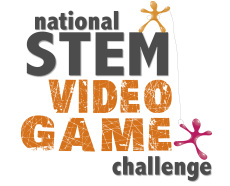 The Cooney Center and E-Line Media are preparing for the third year of the National STEM Video Game Challenge. This year’s competition is open to middle and high school youth, who are invited original game designs beginning in January 2013 for the opportunity to earn recognition and prizes for themselves, as well as monetary prizes for their schools.
The Cooney Center and E-Line Media are preparing for the third year of the National STEM Video Game Challenge. This year’s competition is open to middle and high school youth, who are invited original game designs beginning in January 2013 for the opportunity to earn recognition and prizes for themselves, as well as monetary prizes for their schools.
This year, we’ll also be offering opportunities for mentors to get involved through a new website featuring toolkits, resources and curriculum. Plus, we’ll be featuring some exciting words of wisdom from top game design professionals, as well as offering a forum for aspiring youth designers to get feedback, advice and encouragement from pro mentors.
But you don’t have to wait until January to get started! Check out the stemchallenge.org website for more information on the prize categories, eligibility and streams for 2013. Then, head over to the Resources section to learn about the many tools you can use to make your game and start designing!
We’re also thrilled to be working with an all-star group of sponsors including the AMD Foundation, Microsoft’s Xbox 360, the Entertainment Software Association, the Institute of Museum and Library Services (IMLS) and the HIVE NYC Learning Network, who will reach out to underserved youth across the country through hands-on game design workshops and other supplemental curriculum activities.
This year’s Challenge will also unite a corps of outreach partners and mentors who will be instrumental in supporting youth and teacher participation including BrainPop, the Corporation for Public Broadcasting PBS KIDS Ready To Learn Initiative, Learning Games Network and Edmodo.
Learn more about our partners and sponsors in this press release. And check out the video of last year’s winners below.
Happy Birthday to Us!
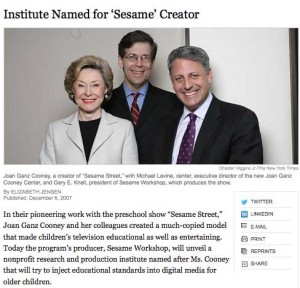
The New York Times, December 6, 2007
This is a big week for the Joan Ganz Cooney Center. It’s our fifth birthday!
To celebrate, we’ve given our website a fresh new look. You’ll find it even easier to find the great content that we’ve got — our publications are now directly available from the top level navigation, and you can find related content even more easily. We’ve also made it easier to share links with your friends and colleagues directly from each page — so spread the news on Facebook, Twitter, Pinterest, StumbleUpon, or wherever you like! You’ll also find it easier to share your thoughts with us in the comments section of each page – so please let us know what you think!
For a look back on our beginning, check out this article from the New York Times, published on December 6, 2007.
We’ve got even more exciting news coming up in the next few weeks. Stay tuned for a new report by Michael Levine and Lisa Guernsey, and for more details about this year’s National STEM Video Game Challenge.
Your Brain on Video Games
Did you know that research shows that people who play video
games tend to have better vision than those who don’t? According to
cognitive researcher Daphne Bavelier, who studies the impact of
video games on the brain, gamers have quite a few advantages over
those who don’t play often. Check out her TED Talk to learn
more.
We’re very excited to be working with Dr. Bavelier on the Gut Sense Action Video Game project — learn more about this exciting partnership that will develop a video game to teach math skills.
Beginning to Use Digital Games in the Classroom: A Video Case Study
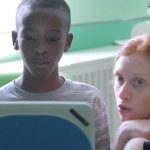 Earlier in 2012, I had the great pleasure of meeting and interviewing several teachers in the New York City area who are pioneering the use of digital games and video game design in their individual classrooms. These interviews were turned into four short video case studies and informed the creation of a first-ever national survey (PDF) of K-12 educators to gauge the impact of digital game use on teaching and student learning.
Earlier in 2012, I had the great pleasure of meeting and interviewing several teachers in the New York City area who are pioneering the use of digital games and video game design in their individual classrooms. These interviews were turned into four short video case studies and informed the creation of a first-ever national survey (PDF) of K-12 educators to gauge the impact of digital game use on teaching and student learning.
After conducting and releasing this research, I had the opportunity to travel outside New York City and present the results of our national survey and show the videos to audiences filled with teachers, school leaders, video game developers, educational policy makers, and investors. At one such event, hosted by The Atlantic magazine in May 2012, I shared a stage with one of our video case study subjects, Joel Levin, a.k.a. “The Minecraft Teacher“, as well as two professors of education who are working directly with teachers to use video games in the classroom. After the panel discussion, I was approached by Jerri Drakes, the Director of Technology at St. Philip’s Academy, a K-8 school located in heart of Newark, NJ. She told me about her school’s growing use of digital games in an attempt to better engage her school’s student body, many of whom come from lower-income families and are not accustomed to the school’s demanding curriculum, but who shine in this friendly, well-resourced educational environment. (more…)
Taking a Closer Look at Kids Online: Opportunities and Challenges in Social Networking Forums
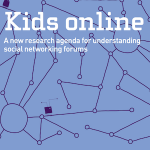 As readers of this blog already know, many people are hopeful about the opportunities that online environments can provide for children. There is great promise for learning technical literacies, developing social skills and contributing to our shared culture through participation in online sites. And indeed, kids are participating in growing numbers on online social sites, both at school and at home. Meanwhile, commercial companies and educational non-profits alike are eager to provide new spaces for such participation, even though that means navigating some tricky regulatory requirements, not to mention shifting public opinion. For while many parents, educators, and children want to take advantage of the new opportunities presented by the latest digital technologies, they are also often concerned about the challenges children might face in social environments online. Privacy, copyright, stranger danger, cyberbullying—these are all issues regularly discussed in the news, around the dinner table and in classrooms across the country.
As readers of this blog already know, many people are hopeful about the opportunities that online environments can provide for children. There is great promise for learning technical literacies, developing social skills and contributing to our shared culture through participation in online sites. And indeed, kids are participating in growing numbers on online social sites, both at school and at home. Meanwhile, commercial companies and educational non-profits alike are eager to provide new spaces for such participation, even though that means navigating some tricky regulatory requirements, not to mention shifting public opinion. For while many parents, educators, and children want to take advantage of the new opportunities presented by the latest digital technologies, they are also often concerned about the challenges children might face in social environments online. Privacy, copyright, stranger danger, cyberbullying—these are all issues regularly discussed in the news, around the dinner table and in classrooms across the country.
The two of us are well aware of the opportunities and challenges present for children in online social networking forums. We’ve each encountered these issues in our respective research on what kids do in virtual worlds and the opportunities for learning and development found in these spaces (in Debbie’s case), and on the ethical and regulatory issues associated with digital spaces specifically designed for and populated by children (in Sara’s case). So we were both very keen to get involved when the chance came up to work with the Joan Ganz Cooney Center on a white paper that delved into what the existing research had to say about kids’ and online social networking—from opportunities and challenges, to current trends and possible trajectories.
The paper, Kids online: A new research agenda for understanding social networking forums, is a first step to documenting pressing questions about children’s involvement online, namely:
- Which children are using social networking forums and what are they doing there?
- What do we know about how online experiences influence children’s social, cognitive, and creative development?
- What kind of research do we need to do now, in order to understand more deeply who is going online, what kinds of things they are doing, and what opportunities or challenges are involved?
- And finally, what should designers, educators, and parents be aware of as they navigate these new environments and try to help children make the most of them?
The results we present in this paper are surprising. First, children tend to be ignored in the big survey research that documents who is going online, how often, and what they are doing. This is partly because children present a challenging audience to reach—what kind of survey can researchers use to talk to children about what they do online (they usually go to parents and it’s just easier to talk to teens and young adults). Another factor is that although there’s lots of anecdotal and qualitative evidence that kids are using popular social media such as Facebook, legal Terms of Use and regulatory policies like the Children’s Online Privacy Protection Act often mean that children are not supposed to be there at all. Another important finding was that large-scale surveys and other research on social networking often overlook the kinds of social networking forums that children tend most to populate. Virtual worlds, console videogames (did you know kids can share creations and chat through videogame consoles?), and project-sharing sites where children share everything from written stories to art to computer-programmed animations are rarely discussed in comparison to social networking sites like Facebook.
Yet we do know some things. There are numerous opportunities for learning in sites that are designed well. This includes opportunities for sharing creations, getting feedback on writing, collaborating, sharing knowledge, developing literacies for reading not just printed text on a page but visual images, hyperlinked information, and the very makings of computers (i.e., computational literacy). The possibilities for using social networking forums to enhance and support children’s participation in cultural production and civic engagement are also extremely exciting. There are promises for social development too – social networking forums can provide lower risk environments for playing with identity (who one is and who one wants to be) as well as many links to other kids they might be intimidated to talk to in school life.
Many challenges lie ahead in regard to social networking forums. We need more research on children’s participation in online environments and studies of the type of social networking forums that children occupy in larger numbers than older adolescents and adults. We need to understand the roles of parents, family members, and friends in shaping children’s participation online, especially since families play a much stronger role in children’s everyday lives than they do in those of adolescents. We need to see things from children’s perspectives too. Instead of just interviewing parents, we need to hear from children about what they are doing, what challenges they are aware of, and what preferences they have when they’re online. And finally, we need to revisit legal and policy questions when it comes to figuring out who is regulating these spaces, under what criteria, and with whose consent.
Because it is a fact that kids are using online ‘social networking sites’ (SNS), or as we argue more broadly, ‘social networking forums’ (SNF), at increasingly younger ages, we need to develop a better understanding of the ways that these digital technologies mediate kids’ socializing as well as the relative opportunities and limitations for their participation in them. We look forward to some lively discussions as we all begin to learn even more about how kids are participating in these online forums.
 Dr. Deborah A. Fields focuses on the intersections of kids’ lives: between personal and academic interests, identity and learning, and across different social settings. These interests have guided her studies in virtual worlds and STEM (science, technology, engineering & math) education in and across classrooms, clubs, and digital social environments. She spent several years studying and writing about identity, avatar design, ethnicity, gender, and cheating in the virtual world of Whyville.net. Related, she recently co-authored a critical review of children’s participation in social networking sites for the Joan Ganz Cooney Center. Current interests include studying issues of aesthetics, learning, and gender in kids’ designs with digital technologies, specifically with computational textiles and computer programs made with Scratch. Thus she is especially interested in digital media that draws together creative production and social sharing of kid-created media. She currently leads and studies workshops for youth that focus on kids’ learning to computer program by making video games, music videos, and blinking clothes. Fields was a postdoctoral fellow at the University of Pennsylvania and a recipient of the Computer Supported Collaborative Learning Best Student Paper award. She is serving as program Chair of AERA’s Special Interest Group Media, Culture, & Curriculum.
Dr. Deborah A. Fields focuses on the intersections of kids’ lives: between personal and academic interests, identity and learning, and across different social settings. These interests have guided her studies in virtual worlds and STEM (science, technology, engineering & math) education in and across classrooms, clubs, and digital social environments. She spent several years studying and writing about identity, avatar design, ethnicity, gender, and cheating in the virtual world of Whyville.net. Related, she recently co-authored a critical review of children’s participation in social networking sites for the Joan Ganz Cooney Center. Current interests include studying issues of aesthetics, learning, and gender in kids’ designs with digital technologies, specifically with computational textiles and computer programs made with Scratch. Thus she is especially interested in digital media that draws together creative production and social sharing of kid-created media. She currently leads and studies workshops for youth that focus on kids’ learning to computer program by making video games, music videos, and blinking clothes. Fields was a postdoctoral fellow at the University of Pennsylvania and a recipient of the Computer Supported Collaborative Learning Best Student Paper award. She is serving as program Chair of AERA’s Special Interest Group Media, Culture, & Curriculum.
Twitter: @StrawbrryBlond
 Dr. Sara M. Grimes is Assistant Professor in the Faculty of Information at the University of Toronto, and Visiting Professor in Book and Media Studies at the University of St. Michael’s College. She researches primarily in the areas of children’s digital media culture(s), play studies and critical theories of technology, with a special focus on videogames. Sara has published work exploring the commercialization of children’s virtual worlds and online communities, the articulation of a critical theory of digital game play, discussions of intellectual property and fair dealing in digital game environments, as well as the legal and ethical dimensions of marketing to children online. Her work has appeared in journals such as New Media & Society, The Information Society, The International Journal of Media & Cultural Politics, Media International Australia and Communication, Culture & Critique, as chapters in edited volumes, as well as various magazines and blogs. She has also presented her research at a number of national and international conferences, workshops and festivals.
Dr. Sara M. Grimes is Assistant Professor in the Faculty of Information at the University of Toronto, and Visiting Professor in Book and Media Studies at the University of St. Michael’s College. She researches primarily in the areas of children’s digital media culture(s), play studies and critical theories of technology, with a special focus on videogames. Sara has published work exploring the commercialization of children’s virtual worlds and online communities, the articulation of a critical theory of digital game play, discussions of intellectual property and fair dealing in digital game environments, as well as the legal and ethical dimensions of marketing to children online. Her work has appeared in journals such as New Media & Society, The Information Society, The International Journal of Media & Cultural Politics, Media International Australia and Communication, Culture & Critique, as chapters in edited volumes, as well as various magazines and blogs. She has also presented her research at a number of national and international conferences, workshops and festivals.
Twitter: @smgrimes
Innovate to Educate: Designing Video Games to Teach Math
 President Obama’s “Educate to Innovate” campaign has brought national attention to improving education in science, technology, engineering and math (STEM). Among other developed countries, the United States currently ranks 17th in science and 25th in math (PISA, 2009). Moreover, there is a chilling gap between our top and bottom performing students, and results suggest that socioeconomic status has a particularly strong impact on student achievement in the United States (PISA, 2009). President Obama aims to bring all American students to the top of the pack in science and math over the next decade.
President Obama’s “Educate to Innovate” campaign has brought national attention to improving education in science, technology, engineering and math (STEM). Among other developed countries, the United States currently ranks 17th in science and 25th in math (PISA, 2009). Moreover, there is a chilling gap between our top and bottom performing students, and results suggest that socioeconomic status has a particularly strong impact on student achievement in the United States (PISA, 2009). President Obama aims to bring all American students to the top of the pack in science and math over the next decade.
Inspired by this movement, the Joan Ganz Cooney Center is exploring innovative ways to harness media to teach STEM skills. One promising area of innovation is game-based learning. Video games can be a powerful learning tool for a range of STEM skills, including systems thinking, interpretative analysis, problem solving, and digital media literacies. Moreover, children are using games more than any other digital activity, with 85% usage penetration among devise users (NPD, 2007). Yet, the potential of games to teach STEM skills is virtually untapped. (more…)
Badges: What Works and What Doesn’t
 This past spring, Global Kids worked on a crowdsourced project to develop “Six Ways to Look at Badging Systems Designed for Learning,” a list of six different goals that badging systems are often designed to meet. During the summer, we beta-tested our own badging system within two of our programs to see in which of these six ways we could demonstrate positive growth.
This past spring, Global Kids worked on a crowdsourced project to develop “Six Ways to Look at Badging Systems Designed for Learning,” a list of six different goals that badging systems are often designed to meet. During the summer, we beta-tested our own badging system within two of our programs to see in which of these six ways we could demonstrate positive growth.
The first program was the Virtual Video Project, which focused on creating an animated film about climate change as part of Global Kids’ participation in the Rio+20 UN Conference on Sustainable Development. The film was designed to raise awareness about real-life events that took place at the Rio+20 Conference and highlight what youth can do to live in a more sustainable world. (more…)
